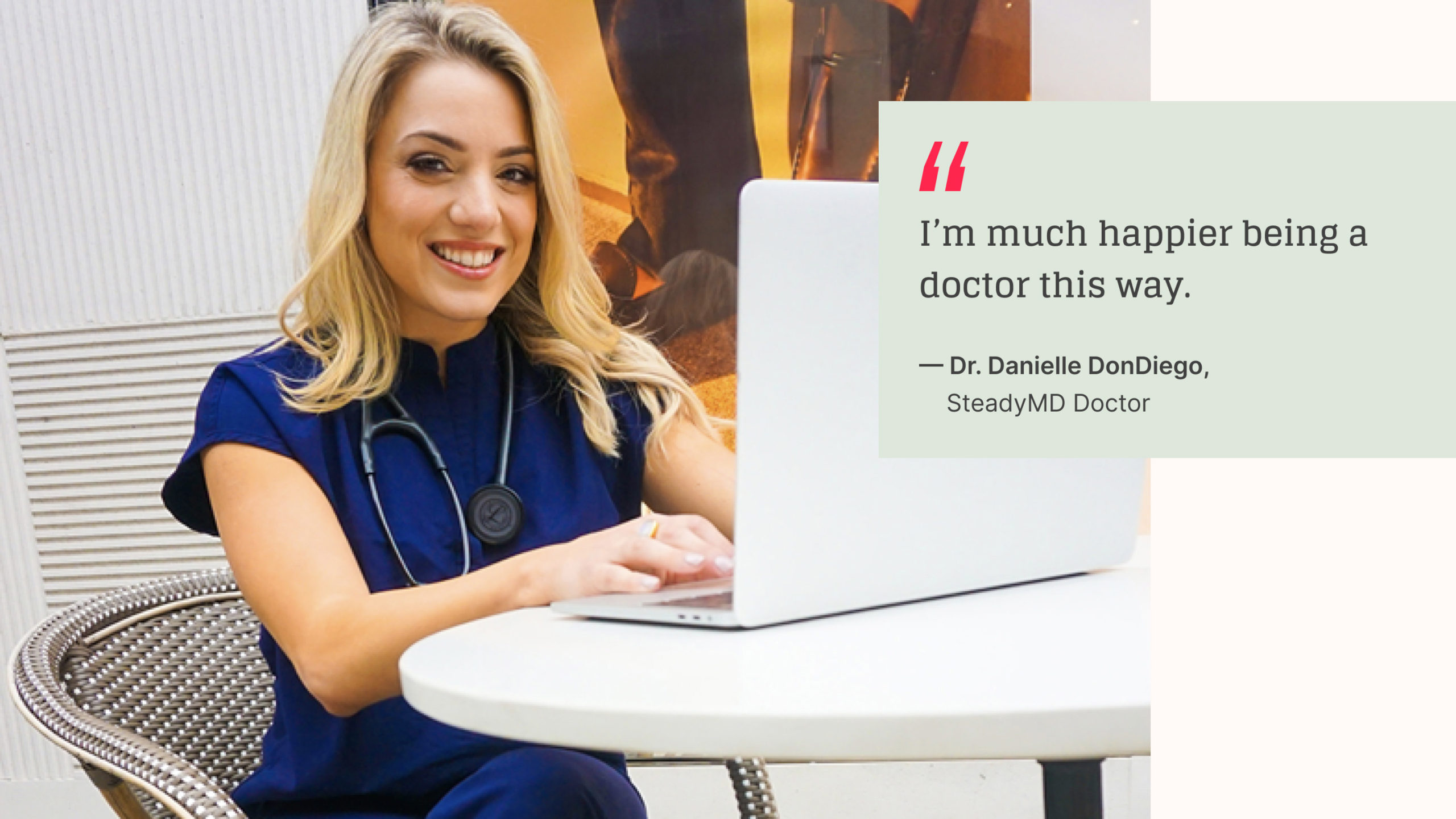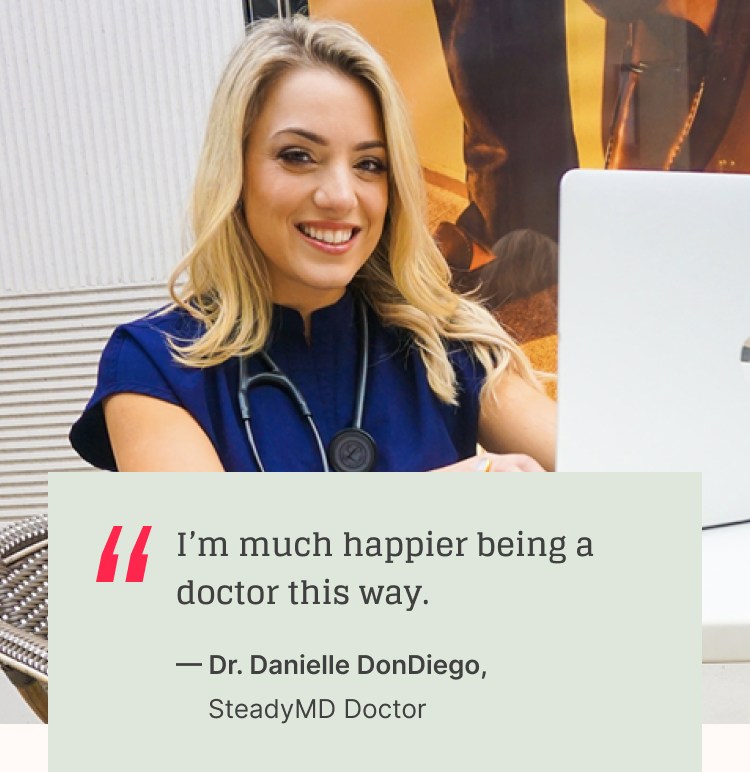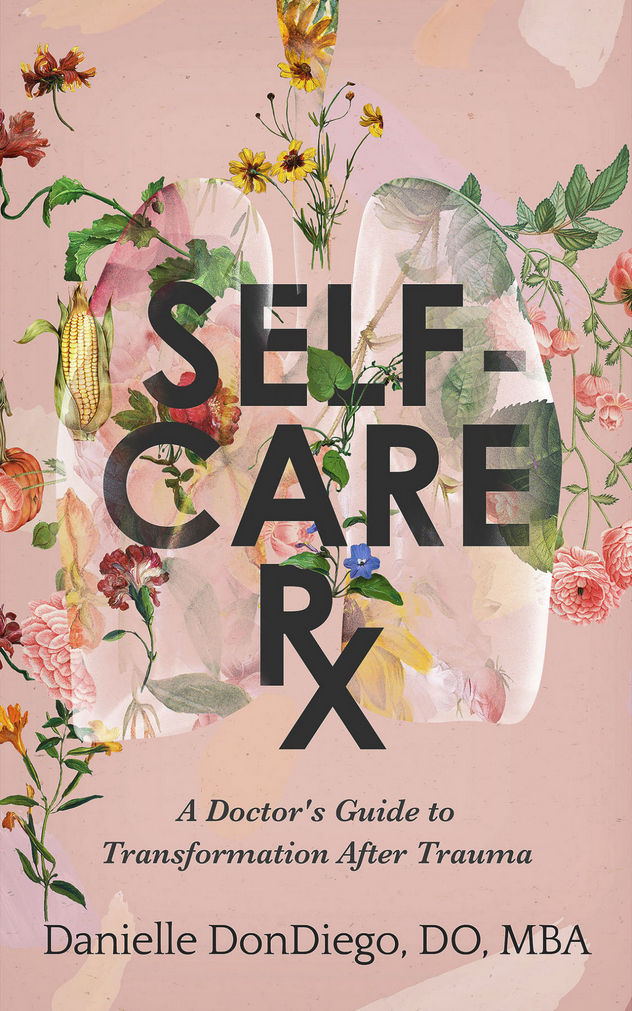Dr. Danielle DonDiego
Primary Care Physician, Obesity Specialist, Self-Published Author


Having been with SteadyMD since our early days, Danielle DonDiego, DO, MBA, is a champion of virtual care. For this edition of “Clinician Close-Up,” we sat down with Danielle, family physician, obesity specialist, author, and self-care advocate to discuss just how much online care benefits clinicians and patients alike.
Could you tell us a bit more about your background? And what exactly brought you to SteadyMD?
I’m an osteopathic physician. I did four years of medical training, in addition to three years of family medicine residency. I’m also board-certified in obesity medicine. When I was at my first job, I had met the founders of SteadyMD, who called to ask me if I was interested in their model.
“It sounded way too good to be true at first, but it was right up my alley, so I immediately said ‘yes.’”
“We’re proving that you don’t have to be in the rat race, and there are other ways for doctors to use their minds to treat the whole patient. And yes, it can be done over the Internet.”
How is working at SteadyMD different from other care models you’ve worked within?
From the perspective of treating a patient, I get a lot more time with them. With the additional time, I feel like I’m taking better care of patients, and they’re being heard. I can pick up on things like mental health issues that can affect their physical health. If you don’t have time to dive into that, then you’re missing a huge part of that person. Patients are openly appreciative of that extra time, especially during that first appointment where they get a full hour. They also appreciate the time in between when they can text me if they have a sinus infection or if they want to ask me something about their diet. We always get back to them within 24 hours, so they have that constant contact.
One of the biggest complaints in medicine is that nobody ever sees the doctor. And when they do, they often wait weeks or months to see them for 10 minutes, and some of their questions don’t get answered. This model solves that for the patient. All of this makes a huge difference in patient experience, but also my experience as a physician.
“I’m much happier being a doctor this way.”
Could you tell us what a typical day looks like for you?
The nice thing is I get to set my own schedule, so it’s flexible. Typically, I leave my schedule open four days a week. I usually have my mornings to myself, which is important to me because I get to start every day on a ‘full tank.’ Then, I get to spend my time in between appointments answering patient messages, looking over labs, sending thoughtful messages back to my patients about their lab results. I have that space built into my schedule so that if a patient needs to see me that same day, we can set up an appointment.
“Plus, unlike working for a large health system, I have time for professional projects outside of SteadyMD. I coach on the side, and I’ve recently come out with a book. I thrive doing a lot of different things at once. I just feel more fulfilled.”
How would you describe the SteadyMD community? Do you feel like you collaborate well with other clinicians?
For the most part, the clinicians are similarly minded, but I also think it’s great that we all have different niches. And we share the same idea that medicine can be different as long as quality is maintained. If I feel that there’s a patient that would be better cared for by another clinician, I never have a problem referring. Although, it doesn’t happen too often because the patients are carefully matched to clinicians based on our profiles. We often will ask each other questions because we have different areas of expertise within medicine. Everybody is so helpful and eager to give their feedback. So, we learn a lot from each other.
Could you tell us a little bit more about your recent book?
My book is called Self-Care Rx (the Rx stands for prescription). This book is about my personal story of struggling with an abusive personal relationship and not taking care of myself, while at the same time, I was showing up to work caring for others. I was going to work every day and functioning incredibly well doing 80-hour work weeks and extracurriculars, but at home, it was a complete disaster. Our level of resilience as doctors is so high that sometimes we don’t check ourselves. But we have to ask: are we just burned out, or are we hiding things that are detrimental to who we are? A lot of physicians were always taught to separate your personal life from work, so with this book, I just smashed that concept completely. I found it useful to tell my story and so do my patients. I think talking about the hard things is important, especially when we deal with life and death for other people every day.
How do you think the healthcare industry can create better work environments for clinicians, whether online or in person?
The first thing that comes to mind is that systems need to honor the needs of healthcare professionals- doctors, nurses, nurse practitioners, and everybody in between. I feel like sometimes the administration side of healthcare forgets that healthcare professionals want to do this job, and we sacrifice a lot to do so. There’s this idea that doctors are superhuman because of what we do. Last year, we were calling doctors heroes as if they could somehow handle the pandemic emotionally and mentally better than others. I don’t necessarily think that’s the case — we’re seeing a lot of people leave the industry because they weren’t properly supported. I think that’s the first step. In general, if hospital systems looked at everybody with a little more humanity, I think that the right changes would follow accordingly.
Any advice to other clinicians considering online care?
I don’t think physicians should fear change. When I first joined SteadyMD to do telemedicine, my peers asked me if I was coming back to medicine, as if I was ditching medicine. I’m not leaving. We are adapting to how the world is and will be. It’s another option, and I want to be a part of it, and people now see how valuable it is due to the pandemic. If we desire to provide more access to care for people who otherwise wouldn’t or couldn’t see a doctor, we need to embrace this transition to virtual care. Telehealth is a middle ground that is filling a gap in healthcare. I hope others can get on board.
